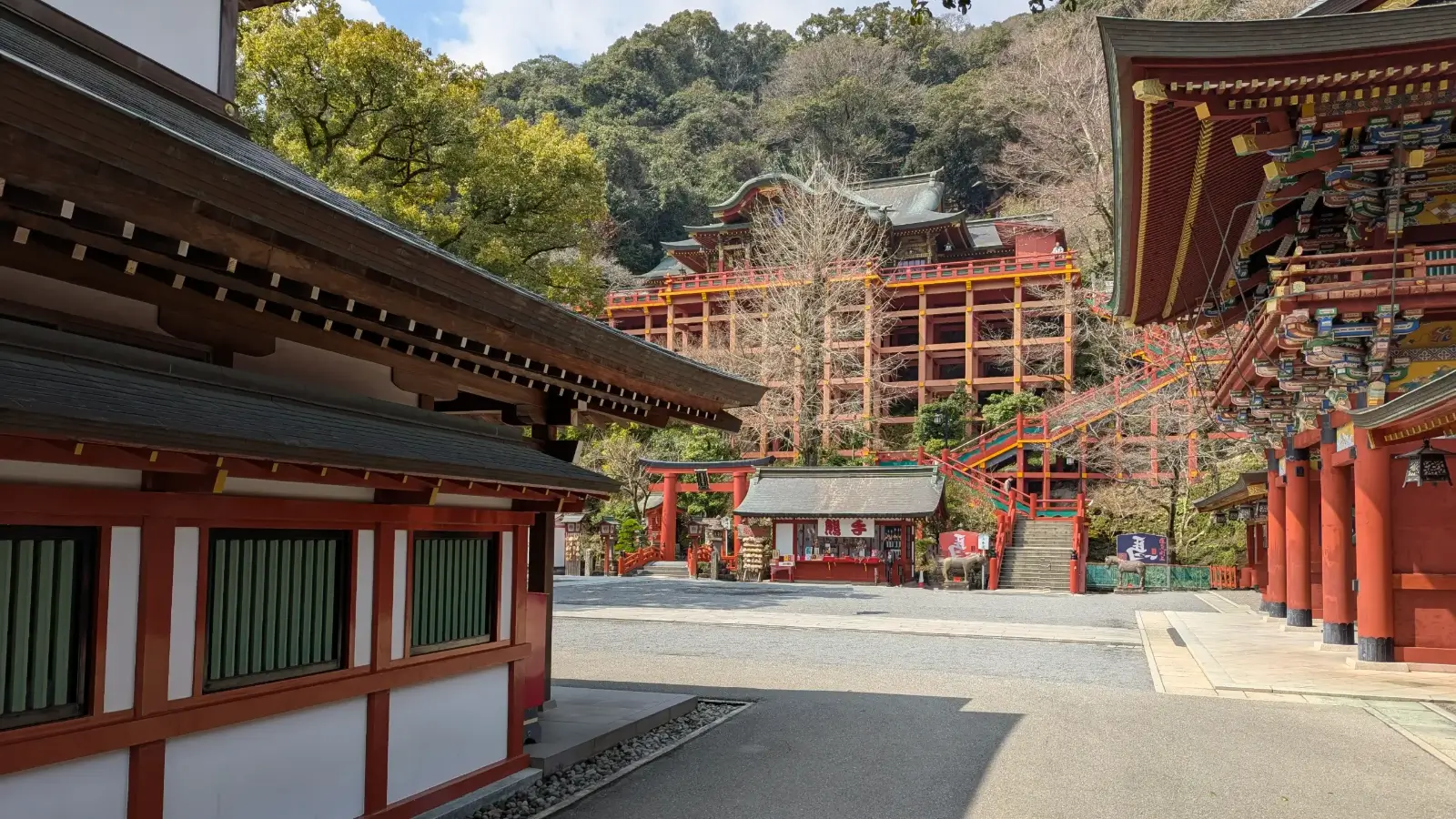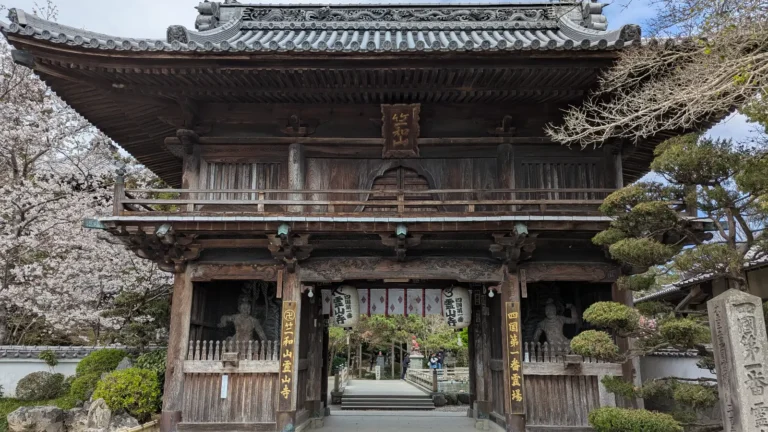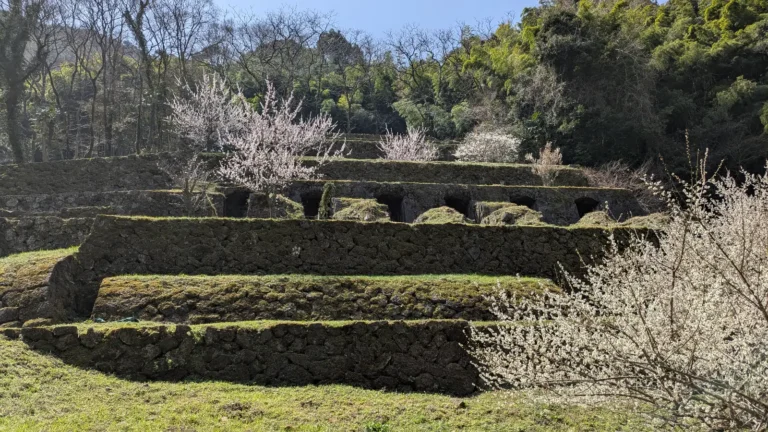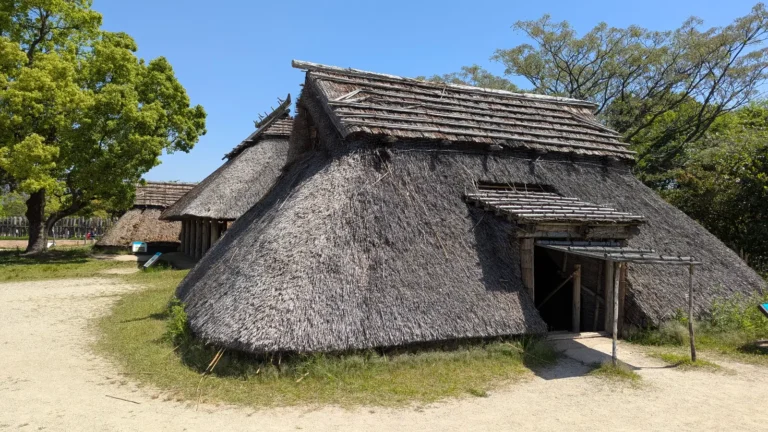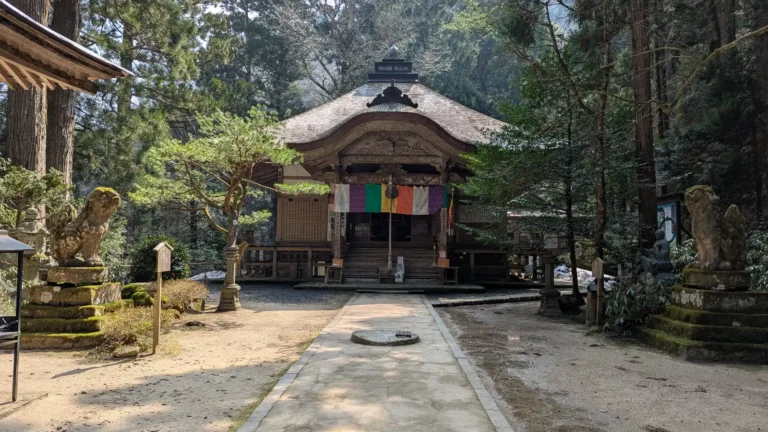Saga: A JOTM Journey
Some places speak loudly. Others whisper.
On the western edge of Kyushu, where the mountains slope softly into tidal flats and stories linger in the breeze, Saga whispers.
This day began not with a checklist, but with a feeling, that somewhere in the folds of coastal forests and quiet villages, something was waiting to be found. What unfolded was not just a journey through space, but through layers: of faith and salt, of silence and wind, of the earth and the unseen.
From vermillion gates built into the hillside to ancient torii swallowed by the sea, from crumbling castles touched by ocean wind to tombs barely marked in the landscape, each place held its own voice. Some bold, some fading, all still speaking.
This wasn’t a day trip. It was a walk through the soft edges of time, where the present bends gently to the past, and the sacred lingers just beneath the surface.
Select links in this guide are affiliate links. They help sustain this space… allowing us to share more, with less dependence on advertising.
*Prices are subject to change.
Yutoku Inari Shrine (祐徳稲荷神社): Beneath the Watch of Foxes and Flame
We began the day at the base of a mountain brushed with vermillion.
Located in the town of Kashima in southern Saga, Yutoku Inari Shrine rises from the hillside like a dream caught between earth and sky. Massive red pillars lift the main hall above the forest, creating a layered, almost floating structure that hums with both power and elegance.
Built in 1687 by the Nabeshima clan, the ruling lords of the former Kashima Domain, the shrine was dedicated to the Shinto deity Inari, protector of agriculture, prosperity, and foxes. For centuries, it has stood as both a spiritual center and a symbol of feudal devotion. Its foundations are as much political as they are sacred.
It’s one of Japan’s most important Inari shrines, yet the crowds felt distant. Here, there was room to breathe, to watch, to listen. We stood in silence as bells rang in the cold air and fox statues lined our path, each one carved with quiet intensity, guardians of this world and the next.
But the shrine doesn’t end at its platform. Behind it, a hidden path winds upward, away from grandeur and into shadow. Stone steps curved through cedar and moss. Lanterns leaned with age. No one else was there.
The further we climbed, the quieter it became. Not an absence of sound, but a presence. The kind that settles around your shoulders and follows you softly up the mountain.
At the top: a weathered shrine, a view over the valley, and the kind of stillness that makes you feel like you’ve crossed a threshold without noticing.
For those who want to follow the path further, we’ve traced the full details in our guide to Yutoku Inari Shrine.
Ouo Shrine’s Floating Torii (大魚神社 海中鳥居): Where the Sea Speaks in Shifts
From the mountains, we followed narrow roads toward the coast, where the land dissolves into water and the line between the sacred and the sea begins to blur.
Along the Ariake Sea coast in Tara Town, Ouo Shrine sits quietly on the shoreline, but it’s not the shrine itself that draws you in. It’s the three torii gates standing in the sea, their silhouettes shifting with the tide.
When we arrived, the water was low. The sand stretched wide, wet and glistening, revealing the path out to the last gate. We walked slowly. Each step brought us closer to something that felt otherworldly.
The gates are weathered, paint faded, edges softened by salt and wind. But they stand tall, steadfast, as the sea rolls in around them. As the tide returned, the water reached their base and then began to rise, swallowing the path behind us.
It’s not a place of drama. It’s a place of quiet transformation. Of watching time move in ripples and tides. Of standing still while the world slowly shifts around you.
The gates do not guard. They wait.
Seasonal tides shape everything here, including the best times to witness it. Our Japan travel seasons guide offers quiet timing for moments like this.
Takezaki Castle Fort (竹崎城址展望台): Where the Wind Remembers What We Forget
The road curved inland again, trading salt air for silence. At the end of a wooded rise, the remains of Takezaki Castle Fort overlooked the bay, not imposing, but quietly resilient.
This was once a strategic coastal stronghold during the late Muromachi and Sengoku periods, built to control shipping lanes and defend against maritime threats in the Ariake Sea. Though now worn and windblown, it was likely tied to the shifting alliances of the Ryūzōji and Nabeshima clans, who shaped much of this region’s medieval history.
There are no towering keeps here. No dramatic gates or reconstructed halls. Just stone foundations, worn earthworks, and the feeling that something once stood here with purpose.
We climbed the short trail as the wind picked up, strong and clean off the water. It rushed through the trees and across the open bluff, whispering through the dry grass that has long since reclaimed the walls.
From the top, we looked out across the Ariake Sea. The same sea that once carried invaders, traders, and maybe even legends. The view was wide and open, yet still felt enclosed, like standing inside a memory that belonged to someone else.
No signs told us what to feel. No crowds pressed in behind us. Just the wind, the stones, and a quiet that made the past feel nearer than expected.
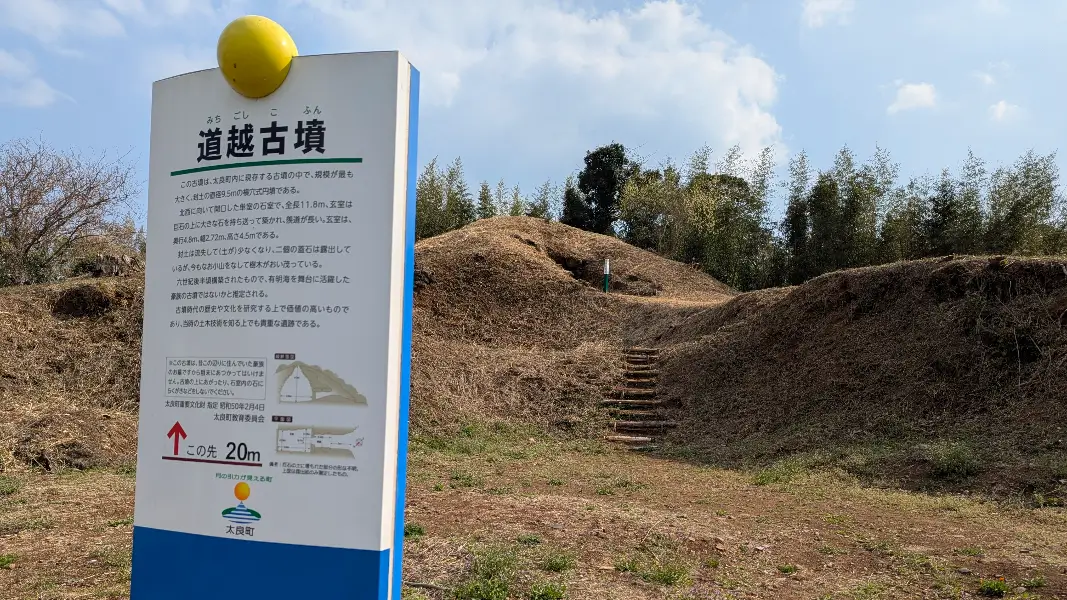
Ancient Burial Mounds: Where the Earth Remembers the Names We’ve Lost
Further inland, beneath low hills and open sky, the ground swelled gently, not with buildings or monuments, but with memory.
There, among quiet fields and farm roads, we found the ancient burial mounds of Tagori Kofun (田古里古墳) and Michikoshi Kofun (道越古墳). From a distance, they could almost be overlooked, grassy rises blending into the landscape, unmarked by crowds or ceremony.
These kofun were built during Japan’s Kofun period (roughly 250–538 CE), a time when powerful regional clans constructed elaborate tombs to honor their dead. They mark an early chapter in Japan’s political formation, when local rulers began to consolidate power and connect with the emerging Yamato state. These mounds, simple in shape, untouched by restoration, are relics from that formative era.
We stepped out of the car and onto a path that wasn’t really a path. No signs. No fences. Just the soft hush of wind over earth that has held its shape for over a thousand years.
The kofun were built to honor the powerful, rulers, leaders, perhaps figures of myth now turned to dust. But what struck us most was not who was buried here, but how still everything felt. Not empty, just patient.
We stood for a while. Not speaking. Just listening to the land. The way it breathed beneath us. The way time folded back in layers no monument could recreate.
These were not tourist stops. These were thresholds, where something sacred had long ago settled into silence.
Hizen Hamashuku (肥前浜宿): Time Fermented in Wood and Stone
By late afternoon, we found ourselves following the scent of something warmer, rice, yeast, and cedar, into the narrow streets of Hizen Hamashuku.
The village felt tucked in, preserved like something long forgotten and gently kept alive. Whitewashed walls, latticed windows, wooden eaves bowed slightly with age. It wasn’t staged. It was simply still here, the way it always had been.
We wandered slowly, letting the lanes guide us past old sake breweries and soy sauce shops, many of them family-run for generations. In one, we tasted a soy sauce aged ten years, dark, mellow, almost sweet. In another, a shopkeeper poured us warm amazake, her voice soft as she explained the fermentation process passed down by her grandfather.
Here, fermentation is more than a method. It’s a rhythm. A way of thinking. A quiet belief that what is aged with care will grow deeper, richer, more meaningful.
The town isn’t loud. It doesn’t ask for attention. It invites you in, then lets you linger as long as you like.
And after a day of wandering shrines and stones, this final stop felt like a kind of exhale.
Villages like this are rare but not alone, tucked between cedar slopes and soft-spoken shrines, Tsuwano lives in a similar rhythm.
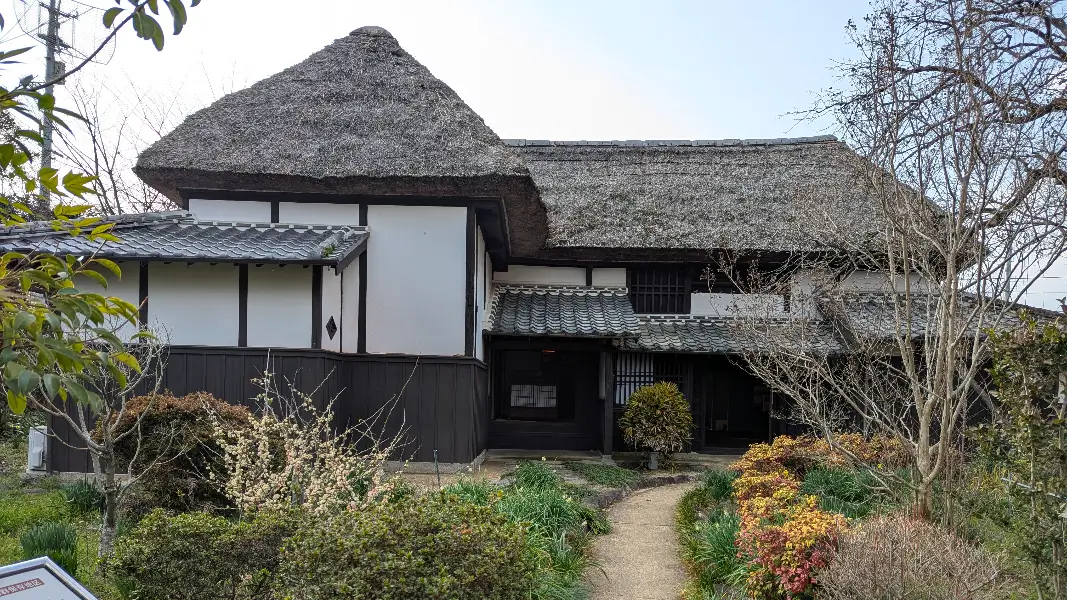
Reflections As The Journey Continues…
Some places you pass through. Others pass through you.
Saga left no bold imprint, no singular peak. Instead, it unfolded slowly, a rhythm of tide and trail, stone and scent. Each stop seemed unconnected at first. But by the end, they had woven together into something whole.
The foxes of Yutoku still guard the path through the mountain.
The torii of Ouo still rise and fall with the sea.
The wind still sings through the ruins of Takezaki Castle.
The earth still remembers names we’ve forgotten.
And in quiet wooden shops, time still ferments, thick and sweet.
This journey didn’t end when we returned to the car. It carried on, in our clothes, in our breath, in the silence between thoughts.
Because places like this don’t ask to be seen. They ask to be felt.
And when you feel them, they stay.
From Somewhere Off the Map
~ Josh

